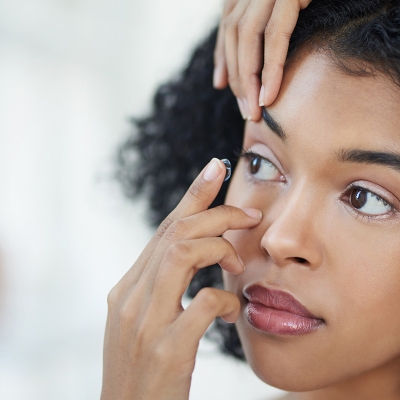What’s the difference between soft and hard contact lenses?
Contacts may come in 2 different types. Here’s which ones might work best for a person’s vision.

Enjoy wearing contact lenses? A lot of other people do too: More than 45 million people in America wear contact lenses.1
People might be surprised to learn that contact lenses are considered medical devices, classified and regulated by the U.S. Food and Drug Administration (FDA).2 That’s why it’s so important for contact lens wearers to choose the right type for their eyes. It’s also important to find the right eye care provider to determine their vision needs.
Most people who wear contact lenses wear the soft type. That could be anywhere from about 84% of contact lens wearers, according to some research,2 to as many as 99%, according to Christopher Lievens, O.D., Ph.D. He’s the director of research at Southern College of Optometry in Memphis, Tennessee.
Why do so many people choose soft contact lenses? And what’s the difference between soft contact lenses and hard contact lenses? Find out below.
Running low on your favorite hard or soft contacts? Order a new supply online today.
Soft contact lenses vs. hard contact lenses
Here’s what to know about the differences between soft and hard contact lenses:1
- Soft contact lenses. These will be made out of a flexible type of plastic. Most people find them to be comfortable and can get used to wearing them after a few days. But soft contact lenses may easily absorb things such as soap or lotion from a person’s hands, which may lead to eye irritation. Also, they tend to be thin, so they might tear or rip more easily.
- Gas permeable contact lenses. People might hear these called gas permeable (GP) or rigid gas permeable (RGP) contact lenses. While they’re also made from a flexible plastic, they tend to be harder than soft contact lenses. For that reason, they might also be called hard contact lenses. Like soft contact lenses, they also allow oxygen to pass through them. A major downside may be comfort. They tend to be less comfortable right out of the box and may take weeks to get used to.
Because so many people wear soft contact lenses, you may wonder why someone might choose hard contact lenses. An eye care provider may only suggest hard contact lenses if soft ones don’t work out the first time or if they have a more complex condition that is better suited for hard contact lenses, notes Dr. Lievens.
How to choose the right kind of contact lenses
When it comes to choosing contact lenses, notes Dr. Lievens, it usually comes down to one factor: material. That’s because contact lens manufacturers use different materials (and scientific processes) to produce contact lenses.
A particular brand, such as Johnson & Johnson, might use “distinctly different” materials to produce their contact lenses, compared with another brand, such as Alcon, says Dr. Lievens. The differences in materials might affect:
- How the lenses float or fit on the surface of the eyes
- How the lenses interact with a person’s eyelids
- How much plastic versus water is in the lenses
- How much oxygen passes through the lenses
- How much of the eye the lenses cover, and their curvature
These are all factors a person might want to consider. The other big one? Personal preference. This might include:1
- How long a person wants to wear their contact lenses
- How often a person needs to replace their contact lenses
- What special features a person wants their contact lenses to have
“When we look at how patients succeed or fail in contact lenses, some of the reasons are comfort,” Dr. Lievens says. It could also simply come down to a person’s willingness to wear and maintain their contact lenses, or how good a person may be at putting them on.
For example, new contact lens wearers — maybe a child or teenager — may find it easier to use a contact lens that sits firmly on the finger when preparing to put it into the eye. “Some are really flimsy,” notes Dr. Lievens, which can make some soft contact lenses more difficult to put in and remove.
What might be the best contact lenses to choose?
It’s ultimately up to personal preference. But it’s a good idea to get guidance from an eye care provider. They will help someone determine which type of contact lens suits them best.
Many eye care providers even allow customers to test out various types of contact lenses. That way, they may be able to find the one that corrects their vision best and is most comfortable.
When it comes to soft and hard contact lenses, people also have options based on how long they want to wear them. Options include:3
- Extended-wear contact lenses. These come in both RGP and soft contact lens versions and usually may be worn up to 7 days without removing them. Some extended-wear contact lenses are even FDA-approved to be worn up to 30 days.
- Extended-wear disposable contact lenses. This type only comes in soft contact lenses and can usually be worn for 1 to 6 days before being thrown out. People might also find extended-wear versions that may be worn up to 30 days at a time.
- Planned replacement contact lenses. These are soft contact lenses that someone could wear on a daily basis. Then they’d replace them on a planned schedule, likely every 2 weeks, or monthly or quarterly.
“I always tell my patients that contact lens comfort is very subjective,” says Dan Lam, O.D., an optometrist and owner of Fort Worth Eye Center in Texas. “I may like one particular product, and I will prescribe it because I have a high success rate with it, but you may not like it.”
So, keep in mind that an eye care provider’s recommendation might not fit a person’s preference, whether it be comfort or fit. “Never be afraid to voice your opinion or ask for a different brand,” notes Dr. Lam. “A good provider will listen to you.”
UnitedHealthcare Vision makes stocking up on contacts easy. Order online and save 10% (and get free shipping on orders over $99 too).
Sources:
- Contacts Cleveland Clinic, last reviewed July 2023.
- Topical review: Contact lens eye health and safety considerations in government policy development Optometry Vision and Science, October 2022.
- Types of contact lenses American Optometric Association.


